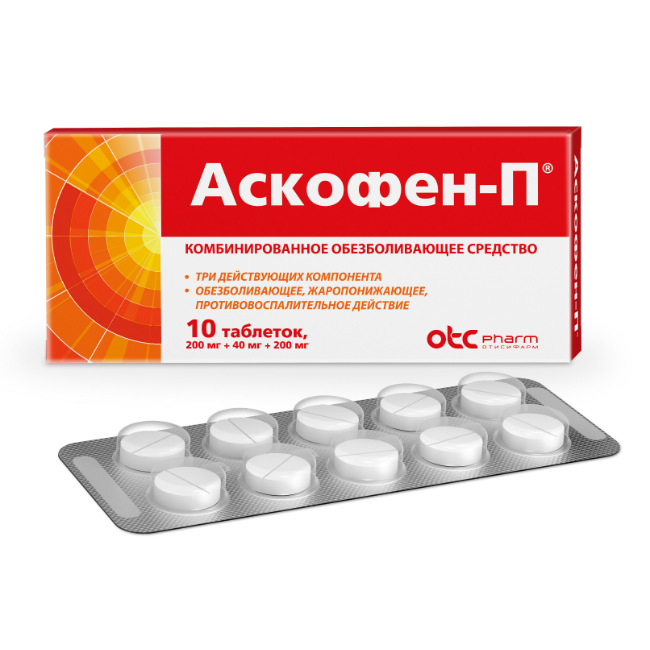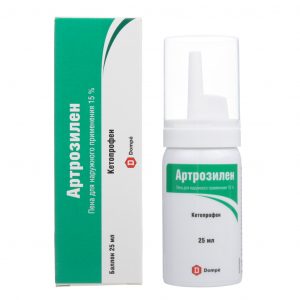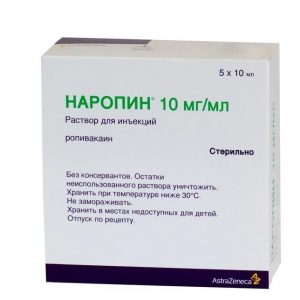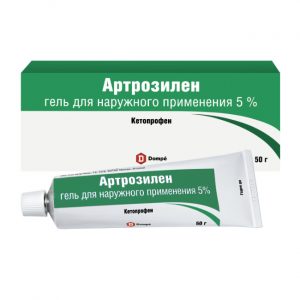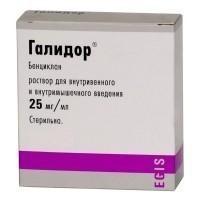Description
Release form
Tablets.
Packing
10 pcs
Pharmacological action
Askofen P – combined drug, It has an analgesic, antipyretic, anti-inflammatory effect.
Acetylsalicylic acid has an antipyretic and anti-inflammatory effect, reduces pain, especially caused by the inflammatory process, and also moderately inhibits platelet aggregation and thrombosis, improves microcirculation in the focus of inflammation.
Paracetamol has an analgesic, antipyretic and extremely mild anti-inflammatory effect, due to its effect on the thermoregulation center in the hypothalamus and mild ability to inhibit prostaglandin synthesis in peripheral tissues.
Caffeine increases the reflex excitability of the spinal cord, stimulates the respiratory and vasomotor centers, dilates the blood vessels of the skeletal muscles, brain, heart, kidneys, reduces platelet aggregation, reduces drowsiness, feeling of fatigue, increases mental and physical performance. In this combination, caffeine in a small dose practically does not have a stimulating effect on the central nervous system, but it helps to normalize the tone of the vessels of the brain and accelerate blood flow.
Indications
moderate or mild pain of various etiologies (headache, toothache, migraine, neuralgia, myalgia, arthralgia, dysalgomenorrhea)
fever syndrome with acute respiratory infections and influenza.
Contraindications
heightened individual sensitivity to the drug
erosive-ulcerous lesions GIT (exacerbation)
gastrointestinal bleeding
aspirin asthma
hemophilia
hemorrhagic diathesis
hypoprothrombinemia
portal hypertension
avitaminosis K
renal failure
pregnancy (I and III trimesters)
lactation (breastfeeding)
glucose-6-phosphate dehydrogenase deficiency
severe hypertension
severe coronary artery disease
glaucoma
irritability
sleep disturbances
surgical interventions involving bleeding
children under 15 years of age.
Caution: gout, liver disease.
Use during pregnancy and lactation
Askofen-P is contraindicated in pregnancy and lactation.
Composition
1 tablet contains acetylsalicylic acid 200 mg,
paracetamol 200 mg,
caffeine 40 mg auxiliary substances:
potato starch,
polyvinyl pyrrolic acid, single-water,
silicone emulsion KE-10-12,
liquid paraffin.
Dosage and administration
Inside a meal with plenty of fluids (milk, alkaline mineral water).
1-2 tablets 3 times a day after meals. The maximum daily dose is 6 tablets. The interval between doses should be at least 4 hours.
For the relief of pain – 2 tablets once.
Ascofn P should not be taken for more than 5 days as an analgesic and more than 3 days as an antipyretic (without prescribing and monitoring a doctor). Other dosages and regimens are prescribed by a physician.
In case of impaired renal or hepatic function, the interval between doses is at least 6 hours.
Side effects
Anorexia, nausea, vomiting, gastralgia, diarrhea, erosive and ulcerative lesions of the gastrointestinal tract, gastrointestinal bleeding, liver and / or renal failure, increased blood pressure, tachycardia.
Allergic reactions: skin rash, Quincke’s edema, bronchospasm.
With prolonged use – dizziness, headache, visual impairment, tinnitus, decreased platelet aggregation, hypocoagulation, hemorrhagic syndrome (nosebleeds, gum bleeding, purpura, etc.), kidney damage with papillary necrosis, deafness, Stevens-Johnson syndrome, toxic epidermal necrolysis (Lyell’s syndrome), Reye’s syndrome in children (metabolic acidosis disorders of the nervous system and psyche, vomiting, impaired liver function).
Drug Interaction
Increases the effect of heparin, indirect anticoagulants, reserpine, steroid hormones and hypoglycemic agents. Reduces the effectiveness of spironolactone, furosemide, antihypertensive drugs, anti-gout agents that promote uric acid.
Increases the side effects of glucocorticosteroids, sulfonylurea derivatives, methotrexate, non-narcotic analgesics and non-steroidal anti-inflammatory drugs.
The combination of the drug with barbiturates, anti-epileptics, zidovudine, rifampicin and alcohol-containing beverages (increases the risk of hepatotoxic effect) should be avoided.
Under the influence of paracetamol, the elimination time of chloramphenicol is increased 5-fold. Caffeine accelerates the absorption of ergotamine.
Salicylamide and other microsomal oxidation stimulants contribute to the formation of toxic metabolites of paracetamol that affect liver function. Metoclopramide accelerates the absorption of paracetamol. Re-administration of paracetamol may enhance the action of anticoagulants (dicumarin derivatives).
Overdose
Symptoms (due to acetylsalicylic acid): nausea, vomiting, gastralgia, dizziness, ringing in the ears, severe intoxication, drowsiness, dyspnoea, collagen,
Initially, central pulmonary hyperventilation results in respiratory alkalosis (shortness of breath, asphyxiation, cyanosis, and evaporation).
As the intoxication intensifies, progressive respiratory paralysis and the separation of oxidative phosphorylation cause respiratory acidosis.
Treatment: constant control of acid-base balance and electrolyte balance depending on the state of metabolism – the introduction of sodium bicarbonate, sodium citrate or sodium lactate.
Increasing reserve alkalinity enhances the excretion of acetylsalicylic acid by alkaline urination.
Storage conditions
Store in a dry, dark place at a temperature not exceeding 25 ° C.
Expiration
2 years.
Do not use after the expiry date stated on the packaging.
Deystvuyuschee substances
Atsetylsalytsylovaya acid, caffeine, Paracetamol
Dispensing conditions from pharmacies
Over-the-counter
Dosage form
Dosage form
tablets
